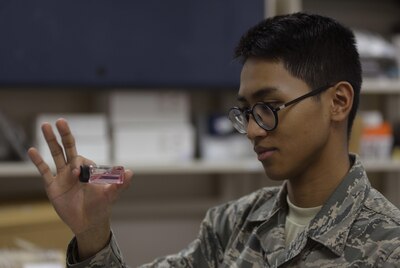By Air Force Airman 1st Class Gerald Willis 36th Wing
ANDERSEN AIR FORCE BASE, Guam, Oct. 30, 2017 — On the
isolated Pacific island of Guam, protecting the limited natural resources and
establishing a safe working environment is essential to mission success.
The 36th Medical Operations Squadron Bioenvironmental
Engineering Flight here takes on the task of seeking out possible health
hazards and bolstering the mission by leading the way in personal safety.
In the same way that the Occupational Safety and Health Act
protects employees at work, bioenvironmental technicians monitor and assure a
safe and healthful working environment for service members.
"Our biggest task is identifying and quantifying
hazards to make a health risk assessment and certify conditions are not
hazardous to employees or the environment," said Air Force Tech. Sgt. Jean
Archambeau, bioenvironmental engineering flight's noncommissioned officer in
charge. "Our job is very vast, and we fit into a variety of specialties.
We conduct routine water sampling at various locations on base -- to include
the dining facilities, passenger terminal and schools -- to ensure drinking
water is within standards. We also perform respiratory protection tests for
industrial workers and gas mask fit testing for all service members."
Monitoring High-Traffic Sites
The flight monitors multiple high-traffic sites on base year
round, frequently conducting tests such as chlorine and pH level water
examinations or heat index calculations using the Wet Bulb Globe Temperature
system.
"Most days on Guam, the heat index reaches [90 degrees
Fahrenheit or higher] and can be a health issue for those that work outside if
the proper controls are not in place," said Air Force Airman 1st Class
Michael Jackson, a bioenvironmental engineering technician. "The Wet Bulb
Global Temperature is the safest way to measure the heat stress in direct
sunlight. This information is used to assess risks and activate safety measures
so the mission may continue as safely as possible in any environment."
As U.S. service members, Andersen airmen are trained often
to be able to complete the mission in a variety of hazardous working
environments such as intense heat or training for potential chemical,
biological, radiological and nuclear threatened areas.
"For the operational readiness exercise Sling Stone
17-1, we have been outfitting the base with the proper [personal protection
equipment] through our M50 gas mask fitment program." Jackson said.
"We have been handling around 15 mask fit tests a day leading up to the
[operational readiness exercise], well on our way to our goal of getting the
base to 100 percent fitted. During the exercise, it will be important that all
airmen are comfortable with their equipment and safe while performing their
duties."
Safeguarding Health
The technicians are dedicated to safeguarding the health of
all airmen here. They have been instrumental in helping the Air Force to have
the lowest disease and nonbattle injury rating in the history of warfare as of
2015, according to Air Force Brig. Gen. Dr. Lee E. Payne, former Air Force
Medical Operations Agency commander, who now is the Air Mobility Command
surgeon.
"We are here to protect all airmen from potential risks
on any given day," Archambeau said. "Upholding the safety standards
and properly outfitting our airmen with the protective equipment they need for
any environment will always be mission-essential."








No comments:
Post a Comment